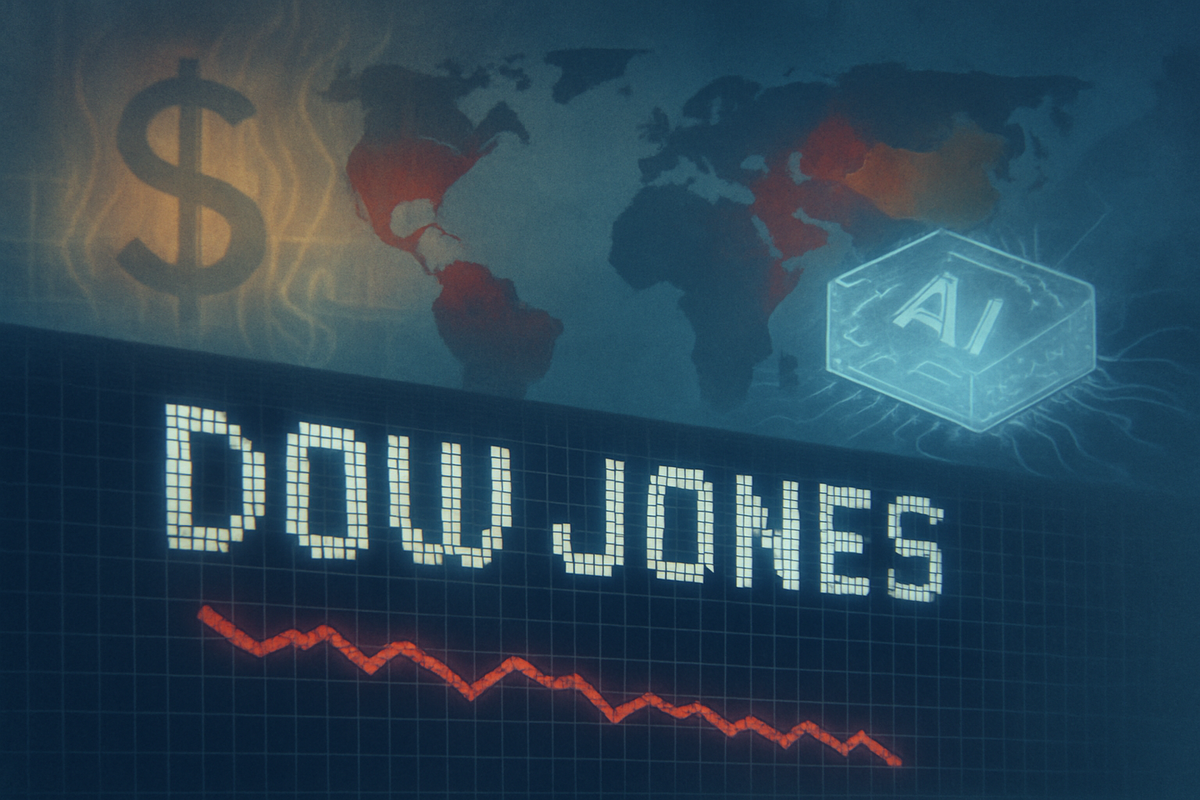
New York, NY – October 15, 2025 – The Dow Jones Industrial Average (DJIA) experienced a fractional dip today, reflecting a palpable sense of caution pervading market sentiment. While other major indices like the Nasdaq and S&P 500 managed to eke out modest gains, the Dow's struggle underscores an underlying apprehension among investors. This minor setback, occurring despite strong third-quarter earnings from some financial heavyweights, points to a broader economic mood grappling with persistent inflation, escalating U.S.-China trade tensions, and growing concerns over a potential "AI bubble."
This fractional decline, though seemingly minor, carries immediate implications for the broader economic mood, suggesting a "wait-and-see" approach is dominating investor psychology. The market's inability to decisively rally indicates that significant global headwinds are tempering optimism, leading to increased volatility and a heightened focus on upcoming corporate earnings and economic data.
The Dow's Fractional Dip: A Closer Look at Market Apprehension
The DJIA's fractional dip on Wednesday, October 15, 2025, marked a day of volatile trading where the index struggled to maintain any upward momentum. This contrasted with the tech-heavy Nasdaq and the broader S&P 500, which closed mostly higher, highlighting a divergence in performance across market sectors. This recent performance is part of a pattern of unease that has characterized the market in the preceding weeks. For instance, on October 14, 2025, U.S. stock markets saw a sharp decline due to renewed U.S.-China trade tensions, with the DJIA dropping 504 points (1.1%). However, later that day, dovish remarks from Federal Reserve Chair Jerome Powell led to a 0.4% rebound for the Dow. Earlier, on October 10, 2025, major indexes, including the Dow, closed sharply lower after President Donald Trump threatened "massive" tariffs on China, causing the DJIA to drop 1.9%, or 878 points. These fluctuations underscore the market's sensitivity to geopolitical developments and central bank commentary.
Leading up to this moment, several global headwinds have been shaping investor sentiment. Persistent global inflation, particularly in the United States, has remained "stickier" than expected, compelling the Federal Reserve to maintain a cautious stance on interest rate reductions. This has kept borrowing costs elevated, impacting corporate earnings and consumer spending. Renewed U.S.-China trade tensions, characterized by tariff threats and retaliatory measures, continue to disrupt global supply chains and create uncertainty for multinational corporations. Furthermore, an ongoing U.S. government shutdown has delayed crucial economic data releases, making it difficult for the Federal Reserve to accurately assess the economy and plan future interest rate trajectories.
Key players and stakeholders involved in this complex environment include the Federal Reserve, whose monetary policy decisions on interest rates and quantitative tightening directly influence market liquidity and corporate financing costs. The International Monetary Fund (IMF) provides crucial global economic assessments, with its warnings about slowing global growth and financial instability often dampening market sentiment. Within the DJIA, major constituents such as Apple (NASDAQ: AAPL), Microsoft (NASDAQ: MSFT), JPMorgan Chase (NYSE: JPM), and Caterpillar (NYSE: CAT) are particularly sensitive to these macroeconomic forces. Initial market reactions have been characterized by heightened volatility, a mix of cautious optimism fueled by strong corporate earnings, and trepidation stemming from geopolitical uncertainties.
Adding another layer of uncertainty are concerns about a potential "AI investment bubble." While the rapid advancements in artificial intelligence have fueled excitement and driven gains in certain tech stocks, some experts are raising alarms about the sustainability of these valuations. Highly valued technology and AI growth stocks, often with high price-to-earnings ratios based primarily on future growth rather than current profitability, are vulnerable to significant corrections. This debate, reminiscent of the Dot-com bubble, contributes to the overall cautious sentiment, especially impacting the tech-heavy components of the broader market.
Navigating the Headwinds: Winners and Losers in the DJIA
The current climate of cautious market sentiment and global headwinds creates a distinct bifurcation within the Dow Jones Industrial Average, separating potential winners from those likely to face significant challenges. Companies with strong balance sheets, pricing power, or defensive business models are better positioned, while those highly sensitive to economic cycles, discretionary spending, or international trade tensions are more vulnerable.
Potential Winners:
- Financials (e.g., JPMorgan Chase (NYSE: JPM), Goldman Sachs (NYSE: GS)): Despite overall economic concerns, banking giants have recently delivered strong earnings, which can inject optimism into the market. Higher interest rates, while a general market headwind, can benefit banks by improving net interest margins. If interest rate cuts materialize in late 2025, as anticipated, it could stimulate capital markets and investment banking activity, further boosting these firms.
- Consumer Staples (e.g., Procter & Gamble (NYSE: PG), Coca-Cola (NYSE: KO), Walmart (NYSE: WMT)): These companies provide essential goods and services, which tend to have stable demand regardless of economic conditions. Their resilient business models make them relatively immune to inflationary pressures and cautious consumer spending, as evidenced by Walmart's continued positive momentum.
- Healthcare (e.g., Johnson & Johnson (NYSE: JNJ), Merck & Co (NYSE: MRK), Amgen (NASDAQ: AMGN)): The demand for healthcare products and services remains largely inelastic. Companies in this sector, particularly those with diversified portfolios in pharmaceuticals and medical devices, offer a defensive buffer against broader market downturns and economic uncertainty.
- Select Technology/AI Infrastructure (e.g., Microsoft (NASDAQ: MSFT)): While AI bubble concerns are prevalent, companies with proven profitability and strong fundamentals, particularly those providing essential AI infrastructure and enterprise solutions, can still thrive. Microsoft, with its robust cloud services and strategic AI investments, stands out as a resilient player.
Potential Losers:
- Consumer Discretionary (e.g., Nike (NYSE: NKE), Home Depot (NYSE: HD), McDonald's (NYSE: MCD), Disney (NYSE: DIS)): These companies are highly susceptible to reduced consumer spending. Persistent inflation eroding purchasing power, while high interest rates make borrowing more expensive, leads consumers to cut back on non-essential goods and services. Brands like Nike and Disney could experience declining sales and lower foot traffic.
- Capital-Intensive Industrials (e.g., Caterpillar (NYSE: CAT), 3M (NYSE: MMM), Boeing (NYSE: BA)): These sectors are highly sensitive to global trade volumes, supply chain stability, and economic growth. High interest rates increase borrowing costs for large capital projects, while U.S.-China trade tensions directly impact international sales and manufacturing. Companies like Boeing and Caterpillar are particularly vulnerable to disruptions in global supply chains and demand.
- Multinational Companies with Significant U.S.-China Exposure (e.g., Apple (NASDAQ: AAPL), Boeing (NYSE: BA)): Companies with extensive manufacturing operations in China or substantial revenue from the Chinese consumer market face considerable headwinds from trade tensions, including tariffs, export restrictions, and potential shifts in consumer sentiment. Apple, with its deep ties to Chinese manufacturing and sales, is particularly exposed to these geopolitical risks.
Broader Implications: Reshaping the Global Economic Landscape
The DJIA's fractional dip and the prevailing cautious market sentiment around October 15, 2025, are not isolated events but rather symptoms of profound shifts reshaping the global economic landscape. This market behavior fits into several broader industry trends, signaling a move towards a more fragmented and complex global economy.
One of the most significant trends is deglobalization. The era of hyperglobalization, which peaked around the 2008 Global Financial Crisis, appears to be giving way to a more localized and protectionist approach. Driven by a desire for supply chain resilience, national security concerns, and geopolitical competition (especially between the U.S. and China), nations are increasingly pursuing strategies like reshoring, nearshoring, and "friend-shoring." This trend is projected to slow global economic growth and demand across various sectors, impacting multinational corporations that thrived in a seamlessly integrated world. The ongoing U.S.-China trade tensions are a prime example of this deglobalization at play, forcing companies to reconfigure their supply chains and diversify their market reach.
Tech regulation is another escalating trend. Governments worldwide are intensifying scrutiny over technology firms concerning antitrust, data protection, and content moderation. The European Union's AI Act, adopted in 2024, introduces a risk-based approach to AI systems, while the U.S. focuses on national security and technological supremacy. This increased regulatory burden, while aiming to foster fair competition and protect consumers, could stifle innovation or create a more fragmented digital economy, impacting the growth trajectories of major tech players within and outside the DJIA.
Furthermore, shifts in consumer behavior are evident. Persistent inflation and rising costs have made consumers more strategic and efficient in their spending. There's a noticeable trend of "trading down while splurging selectively," where consumers are cost-conscious for everyday items but willing to spend on experiences or products that align with their passions. This means companies need to adapt their pricing strategies and product offerings to cater to a more discerning and value-conscious consumer base.
The ripple effects of this cautious sentiment are extensive. Competitors and partners of DJIA companies are forced to adapt to disrupted supply chains and increased costs from protectionist measures. Smaller businesses, often integral to the supply chains of larger corporations, may face increased difficulty in securing financing or managing higher input costs. The competitive landscape is evolving, with other emerging markets potentially benefiting from investment diverted away from countries facing tariffs. Industries sensitive to economic cycles, such as technology and financials, are particularly vulnerable to market volatility, with technology companies facing profit-taking and re-evaluation of their growth-oriented valuations.
Regulatory and policy implications are significant. Central banks, like the Federal Reserve, face limited flexibility to aggressively cut rates due to persistent inflation, even if market downturns exert pressure. Governments are likely to intensify protectionist measures, leading to a more fractured global trading system. In AI, policies aim to ensure ethical and safe development while promoting innovation, but the regulatory patchwork could create compliance challenges for global tech firms.
Historically, periods of market caution and fractional dips are not unprecedented. Comparisons can be drawn to the 1970s stagflation, where geopolitical events combined with domestic economic policies led to prolonged market weakness. The dot-com boom of the late 1990s offers parallels to the current AI investment surge, with concerns about overinflated valuations. More recently, the late 2010s trade wars (e.g., US-China trade tensions starting in 2018) demonstrated how external shocks like tariffs can quickly translate into investor apprehension and market corrections. These historical precedents underscore that a seemingly modest dip can be a harbinger of deeper systemic shifts.
The Road Ahead: Scenarios and Strategic Responses
The path forward for the market, following the DJIA's fractional dip and prevailing cautious sentiment, is fraught with both challenges and opportunities. Short-term volatility is likely to persist, but long-term projections suggest a gradual, albeit uneven, climb for the DJIA, potentially reaching the mid-50,000s by 2029 and even 70,000 by 2030, assuming sustained earnings growth. However, this growth will unfold against a backdrop of a potentially more mercantilist global economy, influenced by evolving geopolitics and China's economic struggles.
Strategic Pivots and Adaptations:
For companies, diversifying revenue streams and supply chains is paramount to mitigate risks from market fluctuations and trade tensions. Robust financial planning, including maintaining healthy cash reserves and flexible budgeting, is crucial for navigating uncertainty. Agile operations and a culture of continuous innovation will enable businesses to adapt swiftly to changing market conditions. For investors, a long-term focus, portfolio diversification across asset classes and geographies, and consistent investment strategies like dollar-cost averaging are key. Reassessing risk tolerance and considering inflation-resistant assets, such as value stocks, are also prudent steps.
Emerging Market Opportunities and Challenges:
Opportunities are emerging in digitalization and technology adoption in developing economies, particularly in Southeast Asia, Africa, and India. The global push for sustainable development and clean energy also presents significant investment avenues. Shifting trade patterns, driven by deglobalization, could benefit emerging markets capable of becoming alternative manufacturing hubs. However, these markets also face challenges from geopolitical and trade policy uncertainty, a strengthening U.S. dollar, and internal economic volatility.
Potential Scenarios and Outcomes:
- Persistent Inflation Scenario: If inflation remains stubbornly high, central banks will continue hawkish monetary policies, leading to sustained higher interest rates. This would dampen corporate earnings and keep stock market valuations under pressure. Companies must focus on operational efficiency and pricing power, while investors should prioritize dividend-paying stocks and those with stable cash flows.
- Escalating Trade Tensions Scenario: Increased tariffs and trade barriers would lead to further supply chain fragmentation, higher production costs, and reduced global trade. Industries reliant on international trade would be most affected. Companies would need to accelerate supply chain de-risking and diversify revenue streams, while investors should reduce exposure to vulnerable sectors.
- Accelerated AI Development Scenario: AI could significantly boost productivity and economic growth across industries, but also bring job displacement and a need for massive workforce reskilling. Companies must strategically invest in AI integration and workforce development. Investors should identify leaders in AI innovation and those effectively leveraging AI for tangible productivity gains, while being mindful of ethical and regulatory challenges.
In a complex world facing all three headwinds simultaneously, the market would likely experience continued volatility and bifurcation. Companies that can leverage AI for productivity gains and those less exposed to global trade might thrive, while others could face sustained pressure. Adaptability, innovation, and strong financial health will be paramount.
Final Thoughts: Prudent Navigation in a Volatile Era
The DJIA's fractional dip on October 15, 2025, serves as a poignant reminder of the inherent volatility and interconnectedness of today's global financial markets. It underscores that even minor movements can signal deeper anxieties among investors, who are constantly weighing robust corporate performance against a backdrop of complex and persistent global headwinds.
The key takeaways from this period are clear: while corporate fundamentals, especially strong earnings growth, provide a crucial floor for equity markets, the overarching narrative is shaped by macroeconomic and geopolitical forces. Persistent inflation, driven partly by tariff-related spikes and services costs, continues to challenge central banks' efforts to normalize monetary policy. Escalating U.S.-China trade tensions are fundamentally reshaping global supply chains and trade dynamics, pushing industries towards deglobalization. Moreover, the burgeoning AI sector, while revolutionary, is facing increasing scrutiny over potentially inflated valuations, raising concerns about a possible "AI bubble burst" and its systemic implications.
Moving forward, the market is poised for continued volatility. While some forecasts suggest a long-term bullish trend for the DJIA, the path will be uneven. A modest global economic slowdown is anticipated, accompanied by sustained, albeit moderating, inflation. The anticipated Federal Reserve rate cuts in late 2025 could offer some relief, but their impact will be balanced against the enduring challenges. There is a discernible shift in market leadership, with small- and mid-cap stocks and financials gaining traction, suggesting a broadening of the market rally beyond the dominant "Magnificent 7" tech giants.
For investors, the coming months demand a nuanced and adaptive approach. It is crucial to:
- Monitor Inflation and Central Bank Policy: Closely track inflation data and the Federal Reserve's interest rate decisions, as these will dictate bond yields and currency movements.
- Track Geopolitical Developments: Pay attention to evolving trade policies, especially U.S.-China relations, and their impact on global supply chains and commodity markets.
- Assess AI Sector Fundamentals: Critically evaluate AI-focused companies, distinguishing between speculative valuations and those demonstrating sustainable revenue and profit growth from AI investments.
- Prioritize Diversification: Spread investments across geographies and asset classes, considering non-U.S. markets and high-quality fixed income for stability.
- Focus on Long-Term Objectives: Resist impulsive decisions driven by short-term market sentiment, adhering instead to a disciplined, long-term investment strategy.
- Watch Key Economic Indicators: Keep an eye on manufacturing output, inventory levels, and labor market data for signals of broader economic health.
In essence, the current market environment, characterized by a fractional dip in the DJIA and lingering caution, underscores the importance of a nuanced and adaptive investment approach. While economic growth persists and innovation continues to drive certain sectors, the enduring impact of inflation, trade tensions, and the potential for an AI market correction demand careful consideration from all investors.
This content is intended for informational purposes only and is not financial advice







